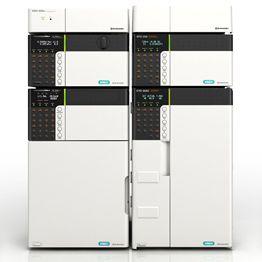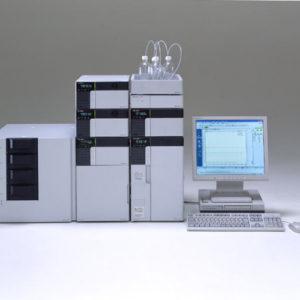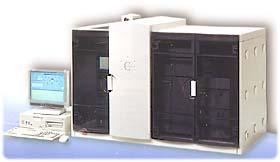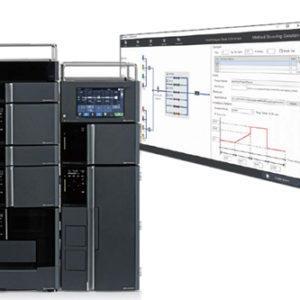Nexera Bio
Nexera Bio Biocompatible Liquid Chromatograph
Описание
An ultrafast inert LC system, Nexera Bio offers the same superior reliability, robustness, and expandability as other Nexera series ultra high performance liquid chromatographs (UHPLC), and is particularly well suited for analyzing protein-based pharmaceuticals, antibody drugs, and other substances developed or manufactured using biotechnologies, such as genetic engineering, cell fusion, or cell culturing. The Nexera Bio is not only compatible with mobile phase solvents containing high concentrations of salts or acids, which are typically used for analyzing antibody drugs and membrane proteins, but has also been designed to inhibit peak tailing caused by adsorption to tubing. Such tailing can especially be a problem when analyzing phosphorylated peptides, which have a high affinity for metals. Consequently, the Nexera Bio helps ensure high-quality data is acquired and analyzed.
Nexera Bio Features
1. Low Carryover
In addition to the low-carryover design for which Shimadzu autosamplers are known, the Nexera Bio features specially selected materials and a rinsing mechanism that inhibit carryover from biological samples. This results in peaks with excellent reproducibility and excellent data reliability, even for samples that previously resulted in carryover that prevented accurate quantitation.
2. Sample Losses (Adsorption) Inhibited Throughout the Entire System
Flow lines have been designed to be chemically inert, enabling analysis of biological samples that adsorb readily to materials such as stainless steel tubing. Consequently, the system can detect peaks that previously could not be detected with adequate sensitivity.
3. Improved Corrosion Resistance
All materials in contact with solutions are coated or a pump is automatically rinsed to withstand analysis using mobile phases with high salt concentrations or that contain halogen elements. The result is reliable, robust operation even when using analytical conditions that would prevent long-term reliability in conventional systems, due to salt precipitation or corrosion.
2. Nexera Bio Advantages
2-1. High-Sensitivity Analysis
The figure to the right shows a chromatogram obtained from flow injection analysis of an adenosine triphosphate (ATP) standard solution (1 mg/L) using Nexera Bio and a general-purpose UHPLC system.
When the general-purpose UHPLC was used to analyze ATP, which has a strong affinity to metal, adsorption in the tubing made peak detection difficult. In contrast, the Nexera Bio system inhibited adsorption in the tubing, so that nicely shaped peaks were obtained and even trace samples could be analyzed with high sensitivity.
| 1st Inj. | 2nd Inj. | 3rd Inj. | |
| Nexera Bio | 6,242 | 6,357 | 6,221 |
| General-PurposeUHPLC | 825 | 1,121 | 1,389 |
2-2. Excellent Reproducibility
The figure to the right shows a comparison of peak area values from successively analyzing an ATP standard solution (1 mg/L) 10 times using Nexera Bio and a general-purpose UHPLC system.
By dramatically reducing adsorption to metal surfaces in sample flow lines, the Nexera Bio system achieves much higher sensitivity and better reproducibility than the general-purpose UHPLC system.
| Mean Value(n=10) | Coefficient of Variation(%) | |
| Nexera Bio | 6,390 | 1.8 |
| General-PurposeUHPLC | 1,177 | 13.0 |
3. Consumables Ideal for Analyzing Biopharmaceuticals
The accelerated pace of development of biopharmaceuticals and drugs based on mid-sized molecules, such as peptide drugs and antisense oligonucleotides, has spurred a need for more accurate analytical and evaluation technology applicable for use in supplying and developing higher quality pharmaceuticals.
Shim-pack Bio Diol and IEX columns offer performance that can help increase the accuracy of analyzing and evaluating biopharmaceuticals and drugs based on mid-sized molecules.
3-1. Example of Using Shim-pack Bio Diol Columns for Evaluating Aggregates in Antibody Drugs
In this example, Shim-pack Bio Diol water-based size exclusion chromatography columns were used to evaluate aggregates in an antibody drug.
Available with four different pore sizes, Shim-pack Bio Diol columns are analytical columns suitable for size exclusion chromatography and intended for bioanalysis. They are ideal for analyzing aggregates or separating fragments in antibody drugs, separating nucleic acids or sugar chains, and measuring molecular weight. The figure below shows an example of using a Shim-pack Bio Diol column to analyze an antibody drug. Reducing the particle size from 5 µm to 2 µm improved aggregate separation and also resulted in higher sensitivity and quantitative accuracy. Furthermore, high-speed, high-separation aggregate analysis was achieved by using a half-length (150 mm long) column.
3-2. Example of Using a Shim-pack Bio IEX Column for Synthetic Oligonucleotides
The Shim-pack Bio IEX is an ion-exchange column suitable for separation of proteins and nucleic acids.
Shim-pack Bio IEX columns are available either as a non-porous type or a porous type intended for laboratory-scale purification of small quantities. For the figure below, a non-porous Shim-pack Bio IEX column was used to analyze synthetic oligonucleotide. The Shim-pack Bio IEX is able to distinguish between molecules that differ by only one salt group.
3-3. Example of Peptide Analysis Using a Mastro™ C18 Metal-Free Column
The chromatogram shown below was obtained by successively analyzing a standard solution of angiotensin I (100 mg/L) five times using a Mastro C18 high-pressure metal-free column in a Nexera Bio system. The 0.12 % relative standard deviation (n = 5) in peak area values indicates excellent reproducibility.
Nexera Bio system combined with a Mastro C18 column achieved both low adsorption and high sensitivity, which should help improve the reliability of biopharmaceutical analysis.
4. Column Product Line
4-1. Shim-pack Bio Diol
| Shim-pack Bio Diol | Diol-60 | Diol-120 | Diol-200 | Diol-300 |
| Substrate | Silica gel | |||
| Functional Group | Dihydroxypropyl (Diol) | |||
| Particle Size | 3 µm,5 µm | 2 µm,3 µm,5 µm | ||
| Pore Size | 6 nm | 12 nm | 20 nm | 30 nm |
| pH Range Used | 5.0 — 7.5 | |||
| Target Molecular Weight Range | 10,000 or less | 1,000 to 100,000 | 5,000 to 300,000 | 20,000 to 1,000,000 |
Ordering Information
| Particle Size | 2 µm | 3 µm | ||||
| Packing Material | Diol-200 | Diol-300 | Diol-60 | Diol-120 | Diol-200 | Diol-300 |
| 4.6 x 150 mm | 227-31009-01 | 227-31010-01 | ||||
| 4.6 x 300 mm | 227-31009-02 | 227-31010-02 | 227-31007-01 | 227-31008-01 | 227-31009-03 | 227-31010-03 |
| Pressure Capacity | 45 MPa | 20 MPa | ||||
| Particle Size | 5 µm | |||
| Packing Material | Diol-60 | Diol-120 | Diol-200 | Diol-300 |
| 4.6 x 300 mm | 227-31007-02 | 227-31008-02 | 227-31009-04 | 227-31010-04 |
| 8.0 x 300 mm | 227-31007-03 | 227-31008-03 | 227-31009-05 | 227-31010-05 |
| 8.0 x 30 mm (Guard Column) | 227-31007-04 | 227-31008-04 | 227-31009-06 | 227-31010-06 |
| Pressure Capacity | 20 MPa | |||
| 20 x 300 mm | 227-31097-01 | 227-31098-01 | 227-31099-01 | 227-31100-01 |
| 20 x 500 mm | 227-31097-02 | 227-31098-02 | 227-31099-02 | 227-31100-02 |
| 20 x 50 mm (Guard Column) | 227-31116-01 | 227-31117-01 | 227-31118-01 | 227-31119-01 |
| Pressure Capacity | 10 MPa | |||
4-2. Shim-pack Bio IEX
| Shim-pack Bio IEX | Q-NP | SP-NP | Q | SP |
| Substrate | Hydrophilic non-porous polymer | Hydrophilic porous polymer | ||
| Functional Group | — CH2N+(CH3)3 | — (CH2)3SO3— | — CH2N+(CH3)3 | — (CH2)3SO3— |
| Particle Size | 3 µm,5 µm | 5 µm | ||
| pH Range Used | 5.0 — 7.5 | |||
Ordering Information
| Shim-pack Bio IEX | Q-NP | SP-NP | Q | SP | ||
| Porosity | Non-porous | Porous | ||||
| 3 µm | 5 µm | 3 µm | 5 µm | 5 µm | ||
| 4.6 x 30 mm | 227-31002-01 | 227-31003-01 | 227-31005-01 | 227-31006-01 | 227-31001-01 | 227-31004-01 |
| 4.6 x 50 mm | 227-31002-02 | 227-31003-02 | 227-31005-02 | 227-31006-02 | 227-31001-02 | 227-31004-02 |
| 4.6 x 100 mm | 227-31002-03 | 227-31003-03 | 227-31005-03 | 227-31006-03 | 227-31001-03 | 227-31004-03 |
4-3. Mastro C18 High-Pressure Metal-Free Column
Peak tailing or adsorption phenomena are known to typically occur when compounds containing a phosphate group, such as phosphorylated peptides and nucleotides, are analyzed using a conventional HPLC system.
Mastro™ series columns are high-pressure metal-free columns that feature a polymer-lined stainless steel column body and highly pressure-resistant polymer material for the frit. Two models are available: the Mastro™ C18 and the Mastro™ PFP2 (pentafluorophenyl).
The Mastro™ PFP2 (pentafluorophenyl) is a reversed-phase column suitable for separating compounds that are difficult to retain or separate using a C18 type column (such as positional isomers or halogen compounds, for example).
The figure to the right shows a comparison of results obtained from analyzing a standard solution of ATP (10 mg/L) in a Nexera Bio system using both a general-purpose ODS column (stainless steel column) and a Mastro C18 high-pressure metal-free column.
The ATP could not be detected using the general-purpose ODS column, due to adsorption to the metal surfaces inside the column, but the ATP was detected without any sample losses using the polymer-lined Mastro C18.
These results show how the Nexera Bio system in combination with a Mastro C18 column can be used to reliably analyze nucleotides and other compounds that include a phosphate group.
| Mean Value(n=3) | Coefficient of Variation(%) | |
| Mastro™ C18 | 38,481 | 4.5 |
| SUS Body C18 | N.D. | — |
5. Nexlock PLS High-Pressure PEEK Tubing and Finger-Tightened Fittings
Nexera Bio systems use highly pressure-resistant PEEK tubing (Nexlock PLS*), reinforced with stainless steel, to connect the autosampler and column. The fittings are designed to directly form a seal along the end surface of the tubing, which minimizes dead volume in joints and helps prevent peak tailing.
Furthermore, the fittings enable tubing to be connected, disconnected, or replaced easily without tools or other supplies.
* 66 MPa pressure capacity indicated in specifications, with replacement recommended after 100 uses
6. TORAST H-Bio Vial
Reportedly, the main mechanisms that cause adsorption of peptides to vials are hydrophobic adsorption and ionic adsorption. With glass vials, adsorption mainly occurs due to ionic adsorption to silanol groups at the glass surface, whereas adsorption mainly occurs on polypropylene (PP) and other polymer vials due to hydrophobic adsorption. Presumably, those involved in analyzing peptides are hoping that a vial that inhibits both types of adsorption will be offered. Therefore, Shimadzu GLC has developed a polymer vial with a special coating that minimizes the adsorption of peptides. Results have indicated that the vial offers extremely good inertness with respective basic, acidic, and neutral compounds. Therefore, it is especially recommended for LC and LC/MS(/MS) users that frequently analyze low-concentration samples.





